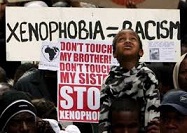Need information on South African xenophobia? Learn more about xenophobia in South Africa…
Immigrants in South Africa have faced discrimination for many years and it reached new heights in 1994. A lot of violent activities took place against South African immigrants and the majority of these were exercised as institutionalized forms of racism as compared to the violence and marginalization occurring due to South African xenophobia. However, surprisingly, since 1994 the advent of democracy has led to a further increase in incidents related to xenophobia in South Africa.
The timeframe between 2000 and 2008 saw the deaths of a minimum the seven people in attacks, which were identified as those stemming from South African xenophobic mentality. The most horrifying attacks occurred in 2008 where serious rioting that broke out in different parts of South Africa and caused the deaths of 62 civilians. Sadly, 21 individuals were actually local South Africans. They were victims caught in a crossfire that was motivated by a xenophobic attack.
Recent History of South African Xenophobia
Many restrictions are placed on immigrants and these go as far back as the historic creation of the Union of South Africa. Each state had different policies with regard to foreigners and there was a heavy prejudice against Eastern European and Southern European immigrants as compared to those wealthier and cultured foreigners arriving from Northern and Western Europe. Further support was provided by the way the immigration act of 1906 known as the Cape Immigration Act (No 30) was set out. The application form needed to be completed in a European language the list of which included Yiddish and applicants were supposed to show a £20 note.
During the period between 1984 and the curbing of hostilities in Mozambique, Africa approximately 250,000 to 350,000 immigrants from Mozambique entered South Africa. Even though the government did not provide them refugee status, they had full support and went on to establish their new homes in the Bantustans, which were known as the black homelands. The apartheid government had established these.
Unfortunately reality for these immigrants seemed to differ from accounts that were characterized as fact. The homeland of Lebowa had actually banned the settlers from Mozambique outright. In contrast the Gazankulu provided the refugees with full support in the form of equipment and land. However they could be deported any time if they entered the main area considered as South Africa proper and it is established fact that they were denied access to economic resources.
Civil War in Congo led to an influx of Congolese citizens into South Africa during 1993 and 1997 and these people were also greeted with xenophobic attitudes. This was evidenced by the fact that these refugees were not provided access to basic health care.
Even though there is not a significant and reliable source of data on record it has been noted that South African xenophobia is on the rise. The main reason for this is attributed to the establishment of a democratic government in 1994. Their subsequent policies have affected the overall attitude towards immigrants. As the new government tries to make a nation building reformist policy, this has led to the exclusion of refugees and the society has become increasingly intolerant and suspicious of foreigners.





